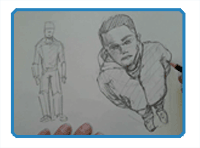
By Matt Fussell
Drawing the human figure is one of the most challenging, yet rewarding activities for an artist. The human figure is ever changing and no two body shapes are the same. This makes figure drawing a challenging skill that you can continue to develop over time. You are truly forced to look closely at the figure when you draw it, leading to enhanced overall drawing skills. Drawing is all about seeing after all, and the stronger you are at understanding what you see, the better you become at drawing.
There is no true formula for drawing people. Because the human figure is so dynamic, a formula doesn’t exist. However, there is a step by step approach that can help the drawing process. Each step is an exercise of observation and comparisons that will lead to a more accurate drawing of the figure.
The first step is to visually measure the subject from the head to feet. Make a judgment about how long the subject is and draw a line on the surface to represent the length from the head to the feet. Depending on the posture, this line may be slightly curved. Drawing this line will ensure that the entire figure drawing will fit on the surface and it will help plan out the rest of the proportions of the figure.
The next step is draw a line for the shoulders and the waist. Again, depending on the position of the figure, these lines may be slightly curved. The vantage point of the viewer will greatly impact the location of these lines, especially if the figure is foreshortened.
After the lines for the waist and shoulders are defined, the structure of the figure can be planned by drawing a stick figure. (Yes, you heard right.) Approach this step as if you are defining the bone structure of the figure. Instead of drawing a line for the torso, a geometric shape is more appropriate. Geometric shapes can also be drawn for the hands and feet.
With the figure’s basic proportions defined on the surface, the artist can “thicken things” up by drawing the contour lines of the figure with confidence. Details of the clothing, features, and props can be defined. The illusion of a light source can be attained through the addition of a range of value.
The figure can be placed in an indefinite number of positions. Depending on the vantage point of the viewer, distortion can occur. In order to capture the figure in these specific types of poses, artists must be able to recognize and replicate the distortion that exists in a pose. Foreshortening refers to this type of distortion in reference to the figure.
Foreshortening is what happens when the human figure is viewed in perspective. When done correctly, foreshortening creates the illusion of space and form in a drawing. This is often because of an extreme point-of-view. This point-of-view can be a "worm's eye view", looking up at the figure; or a "bird's eye view", looking down on the figure. There are other possible angles where foreshortening can occur as well.
Drawing the figure in a pose that creates distortion can be challenging. But, you can draw a figure in perspective using the same steps as you do when drawing a figure in a standard pose. Start with a line from the head to the feet. When the figure is foreshortened, this line will be shorter. The more extreme the angle, the shorter the line. Draw the lines to indicate the shoulders and waist. From there, draw a stick figure. Last, “thicken” up the figure by drawing the contours and details. As you work, be sure to observe the figure and pay special attention to relationships that exist. Also, be sure to look at the positive and negative spatial relationships that happen.
The featured video demonstrates how to draw a foreshortened figure from above.
Here are some more art lessons that you may like...